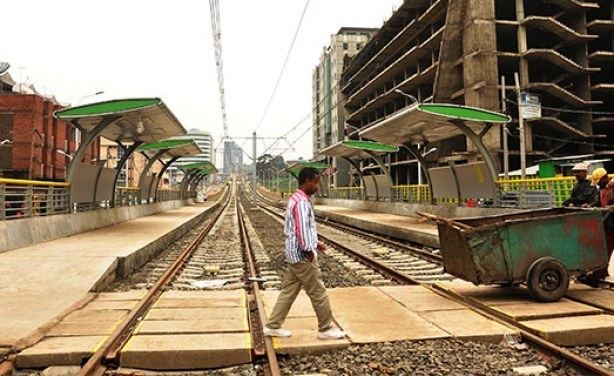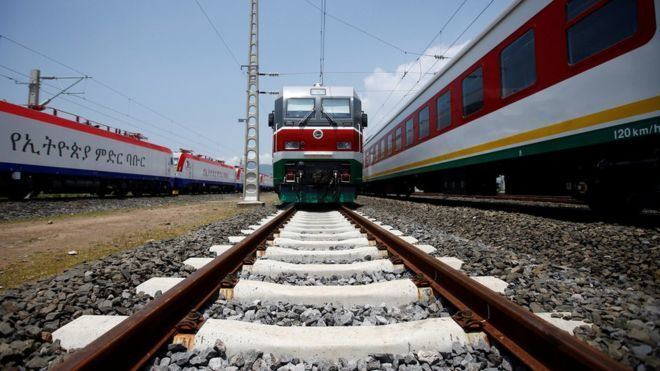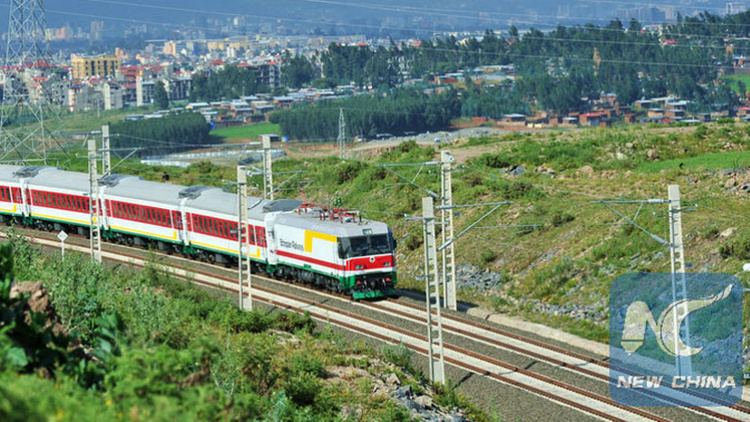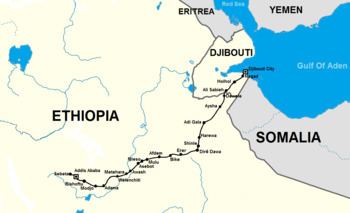System Heavy rail Line length 756 km (470 mi) | Status In trial service | |
 | ||
Operator(s) Ethiopian Railway CorporationSociété Djiboutienne De Chemin De FerChina Railways | ||
The Addis Ababa–Djibouti Railway is a standard gauge international railway that links Addis Ababa with the port of Djibouti on the Gulf of Aden, providing landlocked Ethiopia with railroad access to the sea. More than 95% of Ethiopia's trade passes through Djibouti, accounting for 70% of the activity at the port of Djibouti. The standard-gauge railway replaces the abandoned Ethio-Djibouti Railway, a metre gauge railway built by the French between 1894 and 1917.
Contents

The new line was built between 2011 and 2016 by the China Railway Group and the China Civil Engineering Construction Corporation. Financing for the new line was provided by the Exim Bank of China, the China Development Bank, and the Industrial and Commercial Bank of China. A total of US$4 billion was invested into the railway.

Trial service began in October 2016, and regular services are expected to begin in 2017. The Ethiopian section was inaugurated on 5 October 2016, and the Djibouti section was inaugurated on 10 January 2017. The railway has reduced cargo transit times from 3 days by road to 12 hours by train.

Route

For most of its length, the railway runs parallel to the abandoned metre-gauge Ethio-Djibouti Railway. However, the standard-gauge railway is built on a new, straighter right-of-way that allows for much higher speeds. New stations have been built outside city centres, and the old stations have been decommissioned.

The line is double-track for the first 115 km from Sebeta to Adama, and single-track from Adama to the sea.

The railway begins in Sebeta (2,356 metres (7,730 ft) above sea level), just outside of Addis Ababa. The Ethiopian capital is served by two stations located in the outskirts of the city, at Furi-Labu and Kaliti. Passengers can transfer at Kaliti to the Addis Ababa Light Rail, which gives access to the city centre.
Departing the Ethiopian capital, the line skirts Mount Furi in a wide curve before turning east. At Bishoftu, it crosses over the Addis Ababa–Adama Expressway for the first time. The line then runs southeast alongside the expressway until reaching Adama, where it turns northeast towards Dire Dawa. At Awash, there is a junction with the Mek'ele–Awash Railway, which is still under construction as of 2016.
After passing Dire Dawa, the railway heads directly for Djibouti. Crossing the border between Dewele and Ali Sabieh, it reaches the Djibouti passenger terminal at Nagad railway station, near Djibouti–Ambouli International Airport. Freight trains continue to the Port of Doraleh on diesel power.
History
As the Ethio-Djibouti Railway deteriorated through lack of maintenance, Ethiopia lost railroad access to the sea. The existing metre-gauge railway had been originally built by the French between 1894 and 1917; it had all the deficiencies of a colonial-era railway, with steep gradients and tight curves. Since China was financing the construction of a standard gauge railway network in East Africa, Ethiopia and Djibouti chose to abandon the metre-gauge railway and build a new standard gauge link.
In 2011, the Ethiopian Railway Corporation awarded contracts to two Chinese state-owned companies for the construction of a new standard gauge railway from Addis Ababa to the Djibouti border. The 320 km stretch from Sebeta to Mieso was awarded to the China Railway Group, and the 339 km section from Mieso to the Djibouti border was awarded to the China Civil Engineering Construction Corporation. In 2012, Djibouti selected the China Civil Engineering Construction Corporation to complete the final 100 km to the port of Djibouti.
In 2013, loans totalling US$3 billion were secured from the Exim Bank of China, with US$2.4 billion going to the Ethiopian section of the railway and the balance to be spent in Djibouti. The total costs of the railway amounted to US$1.873 billion for the Sebeta-Mieso section, US$1.12 billion for the Mieso–Dewele section and US$525 million for the Dewele–Doraleh section.
20,000 Ethiopians and 5,000 Djiboutians were hired for construction work. Track-laying was completed on the Mieso–Djibouti segment of the project in June 2015. Although construction was still in progress on other sections, the completed portion of the railway was put into emergency operation in November 2015 to carry grain to drought-stricken Ethiopia. Farmers in Ethiopia had suffered crop failures of between 50% and 90%, and the port of Djibouti was backed up with ships waiting to unload grain.
The completed Ethiopian section was formally inaugurated on 5 October 2016 in the new Furi-Labu railway station in Addis Ababa, by the presidents of Ethiopia and Djibouti. The two primary contractors have formed a consortium to operate the railway for the first 3–5 years, while local personnel are trained. On 10 January 2017, the 100 km section of Djibouti side was inaugurated in a ceremony held in the new Nagad railway station by Djibouti's President Ismail Omar Guelleh and Ethiopia’s prime minister Hailemariam Dessalegn, and the director general of the International Union of Railways (UIC), Jean-Pierre Loubinoux.
Standards
The Addis Ababa–Djibouti Railway was built to the Chinese National Railway Class 2 Standard.
Electrification
The railway is powered by overhead catenary at 25 kV AC. Electrification ends after the Djibouti–Nagad passenger station. To avoid interfering with cranes at the port, freight trains switch to Diesel power between Nagad and the Port of Doraleh.
Power is transmitted at 230 kV and 130 kV to eight substations. Traction power is supplied at 40 km intervals, with 17 stations in Ethiopia and three in Djibouti.
Rolling stock
Rolling stock was built by Norinco in China and by Metals and Engineering Corporation in Dire Dawa.
Passenger coaches are built on the China Railway model 25G design, decorated with national Ethiopian colors. There are four types: coach, couchette, sleeping and dining car.
To meet modern railway standards, braking performance has been improved. As temperatures and solar radiation in the area can vary greatly between night and day and from high mountain to the sea, in order to prevent aging caused by thermal shock and by high ultraviolet light in the plateau environment, all components — rubber, cables and others — have been specifically designed, using laminated glass for blocking more than 90% of UV penetration.
